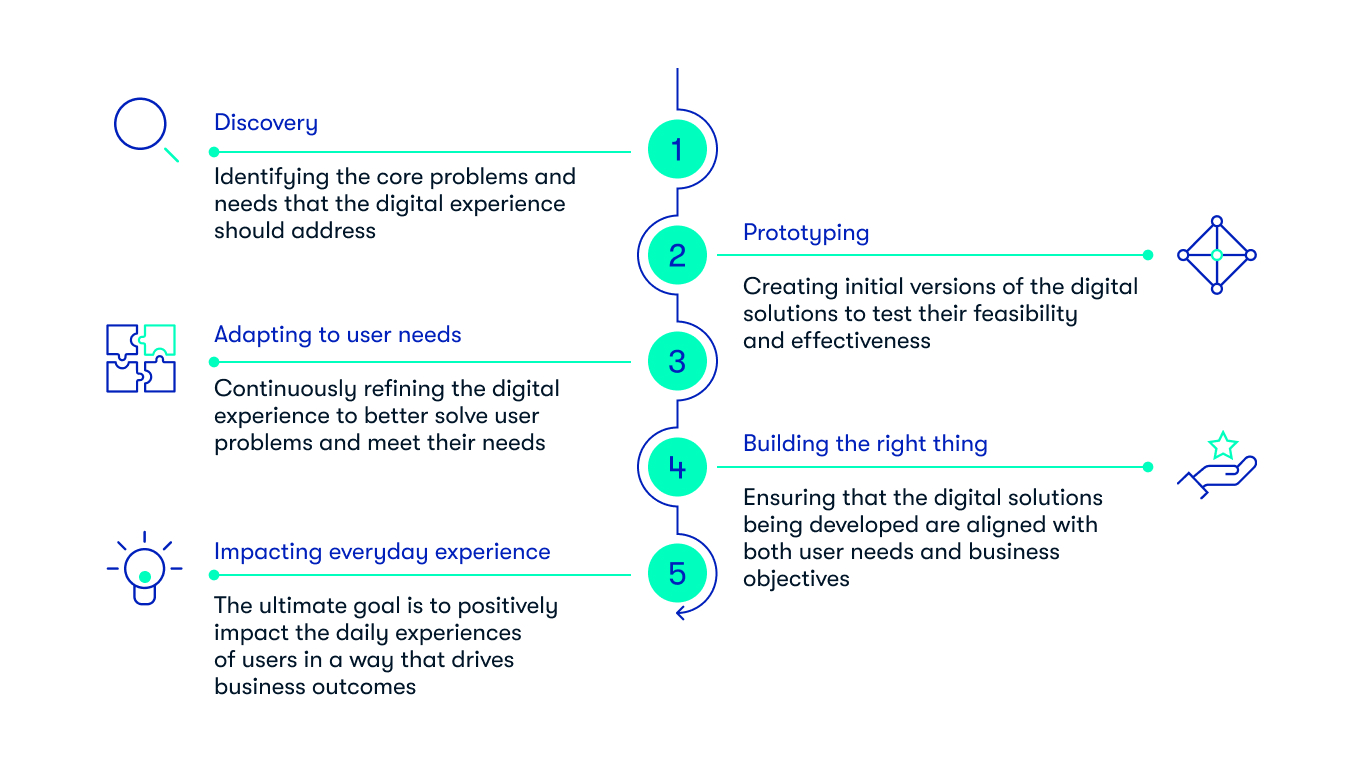Digital experience is an increasingly important part of modern business, and yet it’s still an area where many organisations are struggling to get it right. Of course, it doesn’t help that constantly evolving consumer expectations mean that businesses are aiming at a moving target, but it’s still essential to deliver the easy, positive experiences that customers are looking for. The challenge starts already at formulating the user expectation, and the problem businesses want to solve with their digital experience. Solution discovery proves to be the critical investment that more and more customers entrust us with.
This blog explores some of the best things you can do to transform every single digital experience your organisation offers. We’ll take a look at what digital experience means from a business perspective, how best to approach digital experience management, and the five essential practices that can help you take your strategy forward.
What is digital experience?
Firstly, it’s important to pin down “what is digital experience.” In a nutshell, digital experience refers to any interaction between a person and an organisation that is facilitated by digital technology.
In the modern world, each and every one of us has dozens or maybe hundreds of these digital experiences every single day. You could be shopping on Amazon, checking your balance on a banking app, engaging with a business on social media, or even monitoring your heart rate on your smart watch: all of these are digital experiences.
For businesses, optimising and maximising these digital experiences has never been more important, and the transformation journey starts with detailed roadmapping of digital and customer experiences. For many, a digital touchpoint will be the first place where a customer or end-user will interact with a brand, so leaving a good first impression is vital. Additionally, customers increasingly expect smooth, fast, personalised and stress-free journeys through different touchpoints, especially when buying goods and services. Without good digital experiences every step of the way, customers can very easily take their custom elsewhere, with knock-on effects on revenue, growth and brand reputation.
Types of digital experiences - and bringing them together
Because there are so many types of digital experiences, it can be immensely complicated to manage and coordinate them all. Now more than ever, customers expect consistency and familiarity when they engage with a brand, from the tone of voice in advertising, to the path through the checkout to delivery and fulfilment. Anything that doesn’t look, sound or feel right will breed uncertainty in the customer, dent their confidence and increase their chances of moving to a competitor.
The best way to avoid this situation is to deploy a digital experience platform, commonly known as a DXP. This is made up of a selection of integrated tools that allow all digital experiences to be composed, managed, optimised and standardised from one place. A DXP can incorporate websites, apps, outbound emails, social media platforms, eCommerce sites, point of sale systems, advertising and signage, IoT devices and much more. Deployed well, it enables a much easier, quicker and more coordinated way of creating and delivering digital experiences that customers will love.
Solution journey touchpoints
The journey to delivering exceptional digital solutions and experience involves several high-level touchpoints:

How to maximise your digital experience management
A DXP is just the start of the process of maximising digital experiences. After all, there are so many different kinds of touchpoints, and so many different types of customer, that it can be difficult to know which is the best way forward.
Every business and sector is different, of course, so what’s best for your organisation may well differ from others. But there are five general tips that we’d recommend to every enterprise:
 Determine what needs to improve
Determine what needs to improve
In order to make digital experiences the best that they possibly can be, first it’s important to establish the current state and quality of your existing touchpoints. This can be achieved by analysing website and app traffic and performance; diving into operational data for further insights; and asking customers for feedback directly through surveys and other forms of research. This should go hand-in-hand with analysis of the wider marketplace, and potential target audiences, so decisions can be made in the context of a detailed end-user profile.
This information can then be used to scope out an improvement roadmap, where efforts and investment are focused on the right areas, and the biggest issues can be prioritised. In many cases, it may be appropriate to break this down into separate CX journeys and sections, so that the whole process is more digestible and easier to manage.
 Use facts and tools, not opinions
Use facts and tools, not opinions
The digital experience platforms that we mentioned in the previous section are crucial at this stage. Improving digital experience management absolutely cannot be left to intuition or guesswork: you can be sure that your competitors are making decisions based on hard, objective facts, so it’s essential that you do the same.
Tracking software and CX tools, many of which may come as part of a wider DXP solution, are vital for understanding how customers engage with every touchpoint. Understanding how and why certain experiences work (or don’t work) can add context to the big decisions around making improvements through experience design. This evidence should always be given more weight in the decision-making process than the subjective views of internal leaders or staff members.
 Break down the wanted behaviours of target audiences
Break down the wanted behaviours of target audiences
A key part of delivering positive digital experiences is generating the actions that you want users to take. For example, you might send a personalised email with tailored offers and discounts to an individual customer; the positive experience here is that they will click on the links in your email and go on to complete the purchase.
Looking at the behaviours of target audiences, and comparing this to the ideal actions you want them to take, can identify gaps and areas for improvement in digital experiences. As well as spotting chances to enhance things, you may also uncover touchpoints that aren’t adding enough (or any) value to the experience and can therefore be removed.
 Decide whether it’s an experience remake or a remix
Decide whether it’s an experience remake or a remix
Any digital experience that isn’t doing its job can be ripped up and started again from scratch. However, this isn’t always the best course of action, for two reasons. The first is that some touchpoints can simply be adjusted and overhauled, which is far easier than the clean-sheet-of-paper approach. The second is that a full replacement takes time, costs money, and can lead to substantial business and experience disruption along the way.
Facebook is an excellent example of the approach of evolution rather than revolution. As it has expanded to include more platforms like Instagram, Messenger and WhatsApp, it has centralized its solutions instead of starting from scratch each time. That has given Facebook (or Meta as it is now) more time and space to focus on digital experience, because the foundational technology was already tried, tested and in place.
The analytics and research that we’ve mentioned in the previous points are key to getting these decisions right. They will make it easy to determine whether evolution is more appropriate than revolution, and whether experiences can be tweaked so that the need for a new platform can be avoided.
 Keep on brand
Keep on brand
At a time when it’s more difficult than ever to foster and retain customer loyalty, the strength of your brand is absolutely critical. This doesn’t just mean the breadth of your exposure or the snazziness of your marketing materials: perhaps more important are the more practical principles of accessibility, simplicity, customer service and user-friendliness. Gaining a reliable reputation for being quick, easy and hassle-free to do business with is the most powerful element in getting customers to come back to you, time after time.
It’s easy to lose sight of these things when building a brand, so enhancing customer experiences is a good way to stay on track. In particular, aligning experiences to what’s been successful in the past is vital for new platforms or touchpoints, so that they are instantly recognisable to customers, who feel comfortable with the change.
In summary
Businesses that neglect their customer experiences at any point will quickly find themselves losing customers and market share. With the business world changing so fast at the moment, it’s vital to take a continuous approach to optimising digital experiences, and exploiting new opportunities to get new experiences to market faster than ever before.
If you feel that achieving this is beyond your means, either in terms of time, budget or the skill sets of your workforce, then remember that it doesn’t have to be. An expert partner like Ciklum can give you access to an expert global workforce, and connect you to the tools, platforms and know-how that can transform the experiences you offer, today and tomorrow.
To find out more on how Ciklum can support your specific digital experience needs, get in touch with us today for an informal, no-obligation chat.
Blogs



































